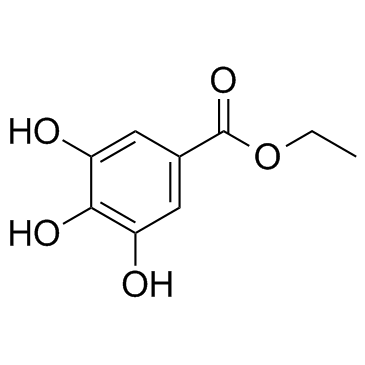Ethyl gallate (Synonyms: Ethyl 3,4,5-trihydroxybenzoate, Gallic Acid, NSC 402626, Phyllemblin) |
| Katalog-Nr.GC31421 |
Ethylgallat ist eine nichtflavonoide Phenolverbindung und auch ein FÄnger von Wasserstoffperoxid.
Products are for research use only. Not for human use. We do not sell to patients.

Cas No.: 831-61-8
Sample solution is provided at 25 µL, 10mM.
Ethyl gallate is a nonflavonoid phenolic compound and also a scavenger of hydrogen peroxide.
Ethyl gallate is a nonflavonoid phenolic compound and also a scavenger of hydrogen peroxide. After treatment for 24 h or 48 h with Ethyl gallate, HL-60 cells show changes in morphology, including shrinkage of the cell membrane and the development of apoptotic bodies. Consistent with these effects, the viability of Ethyl gallate-treated cells decreases in a time- and dose-dependent manner, demonstrating that Ethyl gallate has a cytotoxic effect on HL-60 cells. Ethyl gallate treatment increases the proportion of cells in subG1 phase in a concentration- and time-dependent manner. Treatment of cells for 24 h or 48 h with 50 μM or 75 μM Ethyl gallate increases the percentage of cells in the subG1 phase from a baseline of 2.9% to 26.5% or 52.6%, respectively. It is found that Ethyl gallate treatment of HL-60 cells decreases the expression of Bcl-2 at 75 μM Ethyl gallate, and increases Bax and truncated Bid (tBid) expression at 24 h[1].
No significant difference in the serum total protein, albumin, globulin and glucose is found between the rats fed with A. nilotica (L.) leaf extract on ethyl gallate equivalent basis and those fed with Ethyl gallate alone. Significant differences in total bilirubin level, however, exist between the rats that receive A. nilotica (L.) leaf extract, 500 mg/kg body weight (ethyl gallate equivalent of 10 mg/kg, 0.34±0.01 mg/dL) and those receiving 10 mg/kg body weight of Ethyl gallate (0.26±0.01 mg/dL). Significant difference is found for ALT between groups fed with 500 and 1000 mg/kg body weight of A. nilotica (L.) leaf extract (26.52±1.23 and 30.05±1.38 U/L) and 10 and 20 mg/kg of Ethyl gallate (20.50±0.94 and 24.67±1.13 U/L)[2].
[1]. Kim WH, et al. Ethyl gallate induces apoptosis of HL-60 cells by promoting the expression of caspases-8, -9, -3, apoptosis-inducing factor and endonuclease G. Int J Mol Sci. 2012;13(9):11912-22. [2]. Mohan S, et al. In vitro protection of biological macromolecules against oxidative stress and in vivo toxicity evaluation of Acacia nilotica (L.) and ethyl gallate in rats. BMC Complement Altern Med. 2014 Jul 21;14:257.
Average Rating: 5 (Based on Reviews and 23 reference(s) in Google Scholar.)
GLPBIO products are for RESEARCH USE ONLY. Please make sure your review or question is research based.
Required fields are marked with *




















